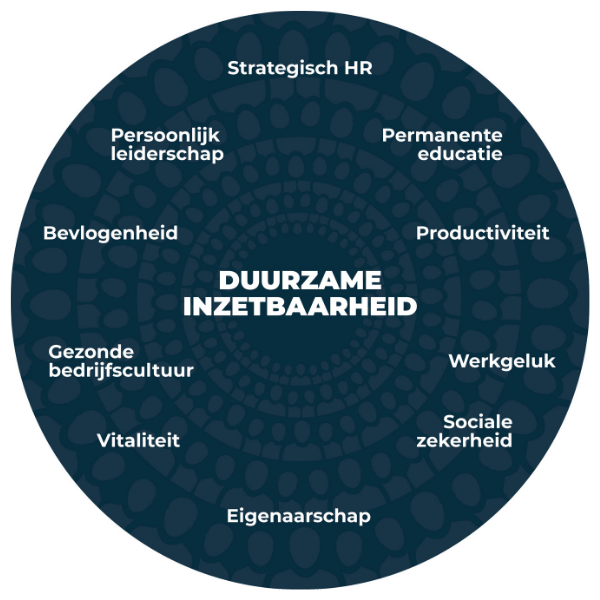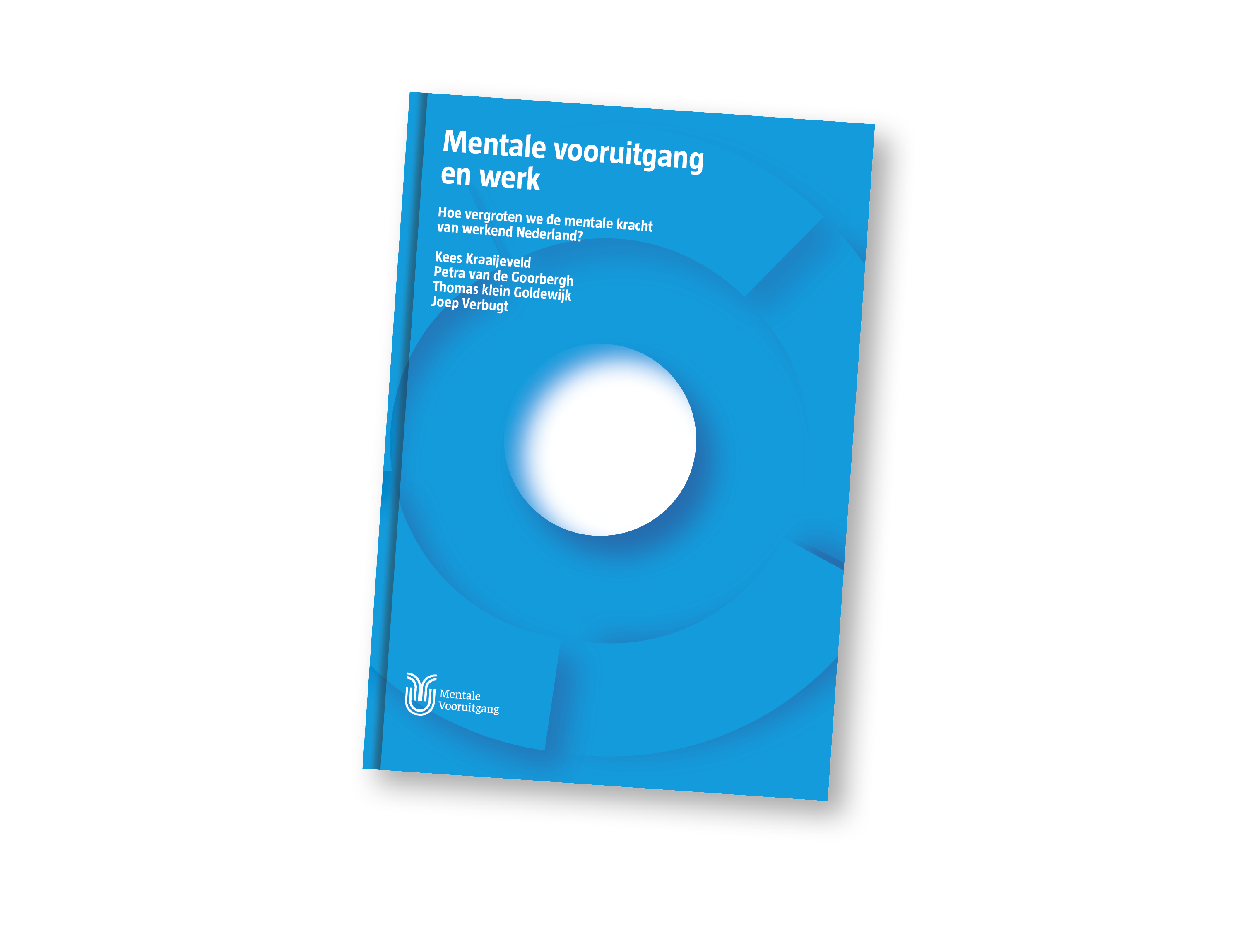Sustainable employability: everything you need to know
Sustainable employability is a concept that is increasingly gaining attention.. But what does it actually mean? And why is it so important? We'll provide you with all the information. Discover why sustainable employability is the key to a future-oriented and successful organization.
- What is sustainable employability?
- Why is sustainable employability important?
- Responsibility sustainable employability
- Employer benefits
- Employee benefits
- 10 elements of sustainable employability
- Investing in the future of your organization
- Sustainable employability: a real-life example
- paraDIGMA groep 's FIT strategy - Sustainable employability practical application
- Frequently asked questions about sustainable employability
- More sustainable employability
What is sustainable employability?
Sustainable employability is a common term. It is used all over the place these days. So what exactly is sustainable employability? At paraDIGMA groep we see sustainable employability as follows: the degree to which employees want (motivation) and are able (ability) to continue working, whether or not with the same employer (employability), while maintaining the ability to take control (personal leadership)over their career.

Why is sustainable employability important?
Sustainable employability in the workplace is crucial. When employees are sustainably employable, it leads to lower absenteeism compared to those who are not. This is because the engagement, sense of responsibility and commitment of sustainably employable employees is much higher. The lower the absenteeism, the more money your company saves. Additionally, sustainably employable employees are healthier and more motivated, leading to increased job satisfaction and higher labor productivity.
Responsibility sustainable employability
Sustainable employability involves a dual responsibility. It's not solely the responsibility of the employee but also largely falls on the employer. The employee is responsible for seeking a job and task that he or she likes and is appropriate. The employer's responsibilities are:
- A positive corporate culture;
- Good working conditions;
- High quality of labor.
Employer benefits
There are several benefits for employers to invest in sustainable employability, including:
- Less turnover
- Increased employee job happiness
- Increased productivity
- Better image
- Increased profitability
Employee benefits
Sustainable employability is often looked at from the employer's perspective. But just as important are the benefits to employees:
- More job happiness
- Less stress
- Increased productivity
- Higher vitality
- Room for development
- More social security
10 elements of sustainable employability
The interaction regarding sustainable employability between employee and employer is different in every organization. This is because every organization is unique and has different challenges. Think of the physical resilience, the vitality policy and the mobility of employees. We refer to the 10 elements of the vicious circle of sustainable employability. All these elements influence the sustainable employability of your organization to a greater or lesser extent and/or are the result of sustainable employability

1. Healthy Organizational culture
We call a Organizational culture "healthy" when employees do meaningful work, experience freedom and receive appreciation. A good complement is when employees provide each other with honest feedback by talking to each other. Not only when things are going well, but also when there is room for improvement. This ensures that employees can develop.
A healthy corporate culture is not accomplished overnight. The speed depends on the current status, the goal and the willingness to achieve this goal. This must come from within the organization itself.
2. Personal leadership
Personal leadership means taking control of your own life. We often divide life into two parts: work and personal. Yet these two parts have a lot of influence on each other. Personal leadership is also about how happy you are and whether you dare to take steps to become (even) happier. Does your job no longer suit you? Then chances are that this will bother you outside of work. The same applies vice versa. But as long as the employee does not take steps, his or her problem will not disappear either.
3. Vitality
Sustainable employability and vitality have different meanings, but are both used in the context of workforce well-being. Vitality is the degree to which employees feel good at work. Sustainable employability focuses on the degree to which employees want to and can continue to work until retirement age. The two terms are thus closely linked.
Increasing vitality within an organization is not as easy as it sounds. This is because all employees are stimulated by something different.
4. Strategic HR
Strategic HR is a way of HRM in which HR practices are aligned with the organization's strategic objectives. This means that the HR department focuses on attracting, retaining and developing employees that the organization needs to achieve its goals.
5. Continuing education
The world is changing rapidly, as are organizations and the people within organizations. To keep employees sustainably employable, it is important that they continue to develop and keep up with changes. Continuing education is an important part of this.
It is up to the organization to give employees room to develop. Subsequently, it is up to the employee to take responsibility in this.
6. Social Security
The degree of social security that an employee experiences has a major impact on his or her behavior within the organization. The government provides a certain level of social security, but strategic HR can play a role in this as well. Organizations can provide additional security with employee benefits.
7. Job satisfaction
Employees who are sustainably employable are generally more vital, more motivated and more committed to their work. They have a good work-life balance and feel supported by their employer. All this contributes to their job satisfaction. In order for an employee to experience job happiness, there are a number of basic elements that an organization can provide.
8. Engagement
Engagement occurs when employees enjoy their work and take pleasure in what they do. Because they enjoy their work, they are more willing to go the extra mile. For example, in the form of training. It also creates a more positive atmosphere in the workplace.
9. Ownership
Ownership is feeling responsible and taking ownership. It is a form of intrinsic motivation. Ownership can be encouraged by the employee him or herself, but also by the organization in which he or she works.
10. Productivity
Productivity is the ability to do a certain amount of work in a certain amount of time. It is determined by the efficiency and effectiveness with which employees work. You can increase employee productivity through strategic HR. Consider good workforce planning and rules around hybrid working.
Investing in the future of your organization
Sustainable employability is a valuable investment in the future of your organization. Before you start actively promoting sustainable employability, it is important to understand the current status of sustainable employability within your company.

Measuring sustainable employability
Sustainable employability is more than just measurable statistics, but it is important to create a foundation with indicators. Some valuable measurement tools are:
- RI&E scan: understanding the risks that can threaten the health and safety of your employees.
- Employee satisfaction survey: understand your employees' satisfaction with their work, their work environment and development opportunities.
- Analysis of absenteeism rates: the frequency and duration of sick leave within the organization.
- Analysis turnover time: the time it takes to fill a new vacancy.
- Training and development analysis: the extent to which employees participate in training and development programs.
These analyses give you a valuable picture of the state of sustainable employability within your organization.
Promoting sustainable employability
The best approach to promoting sustainable employability varies from company to company. It depends on factors such as Organizational culture, the nature of the work, and the needs of employees.
Some general tips are:
- Offer training and development opportunities.
- Encourage a good work-life balance.
- Ensure an open and inclusive culture.
- Pay attention to mental health.
- Encourage a healthy lifestyle.
Sustainable employability is a continuous process that requires attention and involvement from all stakeholders within the organization.
Sustainable employability: a real-life example
paraDIGMA groep and its labels have joined more than 150 companies to increase the sustainable employability of more than 20,000 employees. From SMEs to large organizations, paraDIGMA groep supports them all. Here's how we do it!
Your SME partner
A nice cooperation in the field of sustainable employability is the partnership between branch association Schoonmaken Nederland and De Arbodienst, part of paraDIGMA groep. With extensive experience in both the industry and organization size, De Arbodienst provides support and guidance to both absentee employees and the employer.
They do this by offering three packages: Absenteeism Basic, Absenteeism Plus (including Occupational Health Survey) and Absenteeism Complete (with multiple services in the area of prevention and absenteeism). With the Plus and Complete packages, the other labels of paraDIGMA groep also come around the corner to provide the best possible advice from their own expertise.
From A to Z for every organization
paraDIGMA groep also comes to the rescue of companies that have outgrown SMEs. With comprehensive services in all areas of sustainable employability, we work not only to reduce absenteeism, but also to prevent absenteeism. Prevention focuses on personal leadership and a healthy Organizational culture. Not only do these two pillars ensure that the threshold for calling in sick is raised and for reporting better is lowered, but above all that - before anything happens - employees are engaged in their own development and future.
paraDIGMA groep 's FIT strategy - Sustainable employability practical application
When absenteeism occurs, it is actually already too late to make a difference. That is why we advocate a total approach. The FIT strategy of paraDIGMA groep makes sustainable employability practical for your organization. The FIT analysis provides insights at organizational, team and individual level. We also look at the different generations. This allows your organization to make the shift from curation to prevention and amplification. Insight and awareness is the first step to a sustainable organization with vital employees.
+ THIS IS HOW WE MAKE SUSTAINABLE EMPLOYABILITY PRACTICAL FOR YOUR ORGANIZATION.
Frequently asked questions about sustainable employability
A sustainable employability policy consists of measures that ensure that employees become and remain sustainably employable. Implementing a sustainable employability policy is not a legal requirement, but rather a choice that organizations can make. The term "policy" may not be entirely appropria. It involves creating a positive organizational culture and fostering personal leadership. These are matters where there is no clear right or wrong, and where each organization can find its own path.
The works council (OR) has an important role in promoting sustainable employability within a company. The Works Council can promote sustainable employability in the following ways:
- Taking initiative: making proposals to increase sustainable employability.
- Use right of consent: on important issues related to sustainable employability.
- Advising the director: on topics related to sustainable employability.
- Collaborate: with the director, HR, the occupational health and safety service and other stakeholders.
The Sustainable Employability Index (DIX) measures the sustainable employability of employees within an organization. The instrument was developed by TNO. The DIX can be used to gain insight into the sustainable employability of individual employees or the sustainable employability at group level.
Being employable means that a person is able and willing to perform his or her job. This means that a person is both physically and mentally healthy and has the right skills and knowledge.
Until 2025 there is the Sustainable employability grant for companies and foundations. This means that companies and foundations can apply for subsidies for projects that increase the sustainable employability of their employees. The subsidy can also be used to allow older employees with heavy work to retire earlier.
Implementing a sustainable employability policy is not a legal requirement, but rather a choice that organizations can make. Moreover, it is worth considering whether the term "policy" is appropriate. Sustainable employability goes beyond a formal policy. A positive organizational culture and the encouragement of personal leadership is something you want to promote as a company and where there is no clear right or wrong.
Sustainable employability can be measured in many different ways, but at the same time is difficult to express in numbers. Measurement indicators for sustainable employability include absenteeism rates (both short-term and long-term), employee turnover time within the organization, and the extent to which employees participate in training and development programs. While these measurements provide important insights, sustainable employability goes beyond measurable statistics. Sustainable employability is something you feel and is different for everyone.
The sustainable employability budget is a valuable tool for investing in the well-being and development of employees. It is a budget that is made available to give more attention to making and keeping employees sustainably employable in various ways. Through training for managers, improving workplaces and promoting awareness, organizations can create an environment in which employees can work optimally and remain sustainably employable.
The sustainable employability budget differs from the absenteeism budget in that it focuses on preventive measures and investments in employee well-being and development.
Sustainable employability and vitality are both terms used in the context of employee well-being, but they have different meanings.
Vitality is a component of sustainable employability. Vitality is the degree to which employees feel good at work, both physically and mentally. When they feel good, the chances are higher that they will reach retirement age healthily and sustainably.
Sustainable employability is the extent to which employees are willing and able to continue working until retirement age. The goal of sustainable employability is to keep employees employable on the labor market. Education, vitality and job satisfaction play a role in this.
In short, sustainable employability and vitality have different meanings, but they are connected. Vitality, which focuses on employee well-being and energy, is part of sustainable employability.
More sustainable employability
Learn more about sustainable employability and how to make it happen within your organization in our articles.
In the aftermath of the global COVID-19 pandemic, the way we work has changed dramatically. The period forced organizations to quickly shift to new working models where previously they [...]
It's really true, we live in a digital age. Everything you need within an instant at your fingertips. Not only privately, but also in the workplace, the [...] is growing.
What does it take for Dutch people to become mentally empowered by their work, rather than mentally exhausted by it? How can we (non-)workers, employers and the whole [...]
Psychological complaints are part of life just as physical complaints are. Yet expressing - and responding to - psychological complaints is still very difficult for many people. If someone [...]
OUR THEMES















